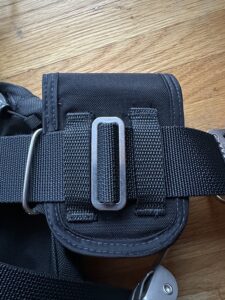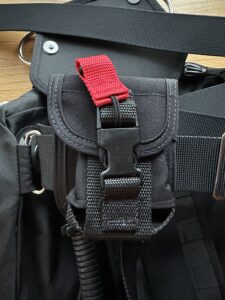Dive Rite 12 lb QR Weight Pocket System
Probably the only thing in diving that’s less elegant than weight pockets are lead weights themselves. However, weighting and weight placement are essential to mastering buoyancy control and trim. If you’ve read any of my other articles, you know I regularly dive using back mount, sidemount and rebreathers. I also teach in both cold and warm water, so my gear requirements change constantly.
I am obsessive about trim, so I buy a lot of trim weight pockets, as well as larger, ditch-able weight pockets. The Dive Rite 12 lb QR Weight Pocket system is made up of a pair of small weight pockets that hold 6 pounds of lead each. The key features are clips that lock the weights in place, with red pull tabs you simply pull to dump, much the same as larger pockets found on a typical BCD.
I love that these pockets take up very little space on my waist, so I can keep d-rings accessible and in logical placements for clipping off whatever needs clipping off—deco bottles or reels for example.
The secure clips are great, pull tabs are great and their compact size is great. But, what’s really great is these Dive Rite weight pockets are the only weight pockets I’ve seen that use an integrated belt slide to hold them in place. If you’ve ever had to add extra hardware to hold weight pockets in place, you know this is no small thing.
Without the belt slide, you have find some other way to secure the pocket. I’ve done everything from adding my own, to drilling holes in the harness to attach trim pockets and get them to stay put.
Attaching Dive Rite QR Weight Pockets
 You would typically attach each weight pocket with the opening facing down. There are two webbing loops with the belt slide in between. Your 2” harness webbing runs through the first loop, into the belt slide, out of the belt slide and through the other loop. It’s a bit of a finger bender if you stiff webbing, but the process couldn’t be easier.
You would typically attach each weight pocket with the opening facing down. There are two webbing loops with the belt slide in between. Your 2” harness webbing runs through the first loop, into the belt slide, out of the belt slide and through the other loop. It’s a bit of a finger bender if you stiff webbing, but the process couldn’t be easier.
The Dive Rite weight pockets work with any webbing harness. They accommodate both soft and hard weights. If you max them out at 6 pounds, hard weights are easier to load. That said, you hardly ever see 6 pound weights, so 5 pound weights are a more likely combination.
Small Ditch-able Weight Pockets
 It’s obvious, but the “QR” in Dive Rite 12 lb QR Weight Pocket stands for “quick release.” Other companies make small quick release weight pockets. I have never seen any that clip shut. XS Scuba, for example, makes a pocket that is also intended to be mounted “upside down,” these use a velcro closure. I used them on one one trip to Curaçao. While on the surface, the tag line hooked under the pocket and sent the weight to the sea floor.
It’s obvious, but the “QR” in Dive Rite 12 lb QR Weight Pocket stands for “quick release.” Other companies make small quick release weight pockets. I have never seen any that clip shut. XS Scuba, for example, makes a pocket that is also intended to be mounted “upside down,” these use a velcro closure. I used them on one one trip to Curaçao. While on the surface, the tag line hooked under the pocket and sent the weight to the sea floor.
The Dive Rite pocket also has velcro, but it is used more to eliminate weight movement. The plastic clip does the heavy lifting. To ditch the weight, you simply pull down on the red tab and the pocket will open.
What the Dive Rite 12 lb QR Weight Pocket is Best For
I’ve been using these Dive Rite weight pockets for 5 or 6 years, and have been recommending them ever since. Originally, I bought them for my warm water, “travel” scuba kit. Basically, that just means an aluminum backplate, with my harness sized to fit my wetsuit instead of a drysuit.
I’m not a big guy—under 160 pounds (usually), so I don’t need much weight to begin with. When diving with a single AL80, I use 8 pounds at most if I am diving in a 3mm wetsuit. Since I want weight distributed in a way that leads to perfect trim, half that goes up on a tank band in trim pockets. That leaves 2 pounds for each QR weight pocket—not a lot. The only complaint I have ever read about the Dive Rite pockets is that small, 2 pound weights can slip out. If you use the velcro closure to reduce that space, this is a total non-issue. 90% of my dives are with 2 pounds in these pockets.
In a 5mm wetsuit, I might add an additional 2 pounds, so instead of 4, 2 pound weights, I’ll have 2-2lb and 2-3lb weights. Most often, the 3s will go in the tank band trim pockets, so it is basically the same setup.
I think most average sized people will find their weight requirements to be similar to mine. In warm water, 12 pounds (the capacity of these Dive Rite weight pockets) at your waist is a lot, and for trim, you would almost certainly want weight distributed higher up.
Dive Rite 12 lb QR Weight Pockets for Sidemount
 Over the Winter, I replaced my Hollis SMS 100 sidemount system with the OMS Sidestream sidemount system. (Read my review of the OMS Sidestream here.)
Over the Winter, I replaced my Hollis SMS 100 sidemount system with the OMS Sidestream sidemount system. (Read my review of the OMS Sidestream here.)
The OMS Sidestream Sidemount scuba system includes spine pockets that accommodate 15 pounds total. These are made up of 3, 5 pound pockets. The Sidestream is my primary system for cold water diving. Depending on my drysuit undergarment and cylinder choice (my go to is a pair of LP50s), 15 pounds is about 4 pounds light. It also puts a strain on my back if I am in the water for a long time.
The Dive Rite 12 lb QR Weight Pockets are perfect for my sidemount system. I really don’t like using waist pockets at all for for sidemount, because bottom clip attachment points are critical in terms of placement. Taking up any of that space with weight pockets forces a compromise most of the time.
However, the Dive Rite weight pockets are narrow, and they can tuck in close to the wing. Generally, I use waist d-rings to clip deco bottles, or to move my primary cylinders down if the bottoms become buoyant toward the end of a dive. For that, the weight pockets don’t affect my d-ring placement at all.
Overall Quality of the Dive Rite 12 lb QR Weight Pockets
In my experience, the Dive Rite pockets hold up very well. The accompanying photos of my backplate show weight pockets after about 350 dives. About 150 of those are rebreather dives, where most often I don’t use any weight. Those don’t really count. Still, the pockets look pretty great given that adding and removing lead is hard on gear.
I wanted to review the Dive Rite 12 lb QR Weight Pockets largely because they fill a need better than any other weight pocket I am aware of. Weight pockets, especially small ones, are rarely given serious consideration. But, they should be. As I think about it, weight placement is everything in diving. It is critical for trim and has a major impact on a diver’s overall comfort. Given that, I encourage divers to dive with backplates & wings as opposed to a traditional BCD, and in some ways, to build their system around weighting requirements.
I’m interested to learn about your experiences with the Dive Rite 12 lb QR Weight Pockets, and if you know of a good alternative from another brand, I’d very much like to hear about that. Please comment below, or shoot me an email. Happy diving!



A generous review that definitely helps me make a buying decision. I have a total of 26 dives w/ AOW cert as reference for decisions… With that as perspective, I’m still on training wheels so your well-reasoned review is appreciated!
Hi Todd, thanks for the nice comment! I am happy to help any way I can. Feel free to ask questions or suggest topics and I’ll provide whatever information I know. – Joe